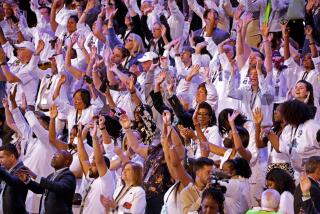‘92 DEMOCRATIC CONVENTION : CAMPAIGN : GETTING THE PICTURE
- Share via
Conventions have become highly telegenic events, designed around networks’ needs. The heart of the network operation is the control room, in most cases contained in a large truck at the convention site. With about a dozen live cameras to call on, the director and executive producer coordinate the broadcast. The director handles the production aspects; the producer keeps track of content and breaking events:
Understanding the Checkerboard of Shots 1. Network Ret (network return): The signal going out over the air from New York, commercials and all
2. Replay machines: Quick replays and taped inserts. 3. Remote shots: Cameras located at candidate’s hotel, outside convention hall and other spots around the city 4. Pre-recorded material: More taped material, provided by camera crews around the city. 5. Line: The shot going out over the air
6. Preview: Used to check shots and graphics before they are used on the air
7. Convention cameras: The shots from convention floor, camera platform, even a robotic camera stationed high in the lighting grid
The Front Line Executive Producer: In contact with convention manager, correspondents, network supervisor in New York. Keeps track of breaking stories and what other networks are doing. Director: Overall responsibility for the visual look. Makes snap decisions on camera shots, remotes, graphics, tape inserts. Assistant director: Keeps track of time and commercials; sometimes prepares cameras for the next shot. Technical director or “switcher”: Executes director’s orders, hitting the buttons that actually change cameras, insert graphics or taped material
Milestones in Broadcast Coverage 1924: Coast-to-coast radio coverage 1952: Coast-to-coast TV coverage 1956: First anchor team (Chet Huntley and David Brinkley) 1964: Debut of portable cameras 1968: Color coverage 1972: Last year ABC, NBC and CBS provided gavel-to-gavel coverage
Total coverage for ABC, NBC and CBS in:
1968: 85 hours
1988: 44 hours
1992: 15 hours
Getting the Picture to your Home
1. Portable camera captures an image on the convention floor. 2. To get the cableless camera’s signal off convention floor, a microwave dish is used. A technician points the camera’s dish at a receiver site on the 11th level of the Garden. 3. The shot is now on the way to the TV truck. It flashes onto one of many small monitors. If the director likes the shot, he calls out the camera number. A technician hits a button and the shot appears on the main monitor, or “line.” 4. The shot from the convention floor is now sent by fiber optic cable to the network’s studio in Manhattan. Once there, it is relayed--again by fiber optic cable--to a satellite transmission site. 5. The signal goes by satellite to the network’s local station. The local station sends it on to viewers’ TV sets by antenna or via a local cable franchise.
Source: CBS, NBC, ABC
More to Read
Get the L.A. Times Politics newsletter
Deeply reported insights into legislation, politics and policy from Sacramento, Washington and beyond. In your inbox twice per week.
You may occasionally receive promotional content from the Los Angeles Times.










